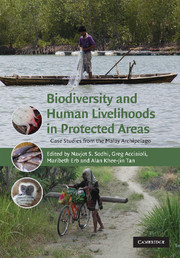Book contents
- Frontmatter
- Contents
- List of contributors
- Acknowledgements
- 1 General introduction
- Part I Conservation needs and priorities
- 2 Introduction to Part I
- 3 Delineating Key Biodiversity Areas as targets for protecting areas
- 4 A Master Plan for Wildlife in Sarawak: preparation, implementation and implications for conservation
- 5 Indonesia's protected areas need more protection: suggestions from island examples
- 6 Birds, local people and protected areas in Sulawesi, Indonesia
- 7 Importance of protected areas for butterfly conservation in a tropical urban landscape
- 8 Biodiversity conservation and indigenous peoples in Indonesia: the Krui people in southern Sumatra as a case study
- 9 Involving resource users in the regulation of access to resources for the protection of ecosystem services provided by protected areas in Indonesia
- 10 Conclusion to Part I
- Part II Conservation with and against people(s)
- Part III Legal and governance frameworks for conservation
- 29 General conclusion
- Index
- References
5 - Indonesia's protected areas need more protection: suggestions from island examples
from Part I - Conservation needs and priorities
Published online by Cambridge University Press: 12 November 2009
- Frontmatter
- Contents
- List of contributors
- Acknowledgements
- 1 General introduction
- Part I Conservation needs and priorities
- 2 Introduction to Part I
- 3 Delineating Key Biodiversity Areas as targets for protecting areas
- 4 A Master Plan for Wildlife in Sarawak: preparation, implementation and implications for conservation
- 5 Indonesia's protected areas need more protection: suggestions from island examples
- 6 Birds, local people and protected areas in Sulawesi, Indonesia
- 7 Importance of protected areas for butterfly conservation in a tropical urban landscape
- 8 Biodiversity conservation and indigenous peoples in Indonesia: the Krui people in southern Sumatra as a case study
- 9 Involving resource users in the regulation of access to resources for the protection of ecosystem services provided by protected areas in Indonesia
- 10 Conclusion to Part I
- Part II Conservation with and against people(s)
- Part III Legal and governance frameworks for conservation
- 29 General conclusion
- Index
- References
Summary
Introduction
Intact, biodiverse ecosystems provide invaluable life-support services, raw natural resources, and cultural necessities ranging from recreational to spiritual. Moreover, they are literally economically priceless (Costanza et al. 1997). It is widely appreciated that ‘biodiversity is good’ and that ultimately, human well-being and persistence will depend on our ability to preserve it for future generations.
Biodiverse ecosystems, however, are not evenly distributed on our planet – they are patchy and concentrated in tropical regions (Myers et al. 2000). Likewise, costs and benefits of conserving biodiversity are not evenly distributed (Balmford et al. 2003). Our ability to conserve biological diversity is constrained by global trends of exploitation, pollution and habitat loss – all increasing because of human-population growth. Unfortunately, areas of accelerating human population growth overlap many areas of highest biodiversity where resources to protect this diversity are fewest (Cincotta et al. 2000) and land-conversion pressures greatest. As human populations continue to expand, we are faced with even more pressing needs to conserve and protect diverse ecosystems.
Protected areas: theory meets reality
Protected areas are, by definition, designed to protect biological diversity from threats to its continued existence. They are the cornerstone of most biodiversity efforts because species need habitats and they might be the best way to ensure the long-term conservation of biodiversity (du Toit et al. 2004). Unfortunately, many protected areas are only ‘paper parks’ that are not only highly degraded, but also the target of continuing exploitation (Curran et al. 2004).
- Type
- Chapter
- Information
- Biodiversity and Human Livelihoods in Protected AreasCase Studies from the Malay Archipelago, pp. 53 - 77Publisher: Cambridge University PressPrint publication year: 2007
References
- 4
- Cited by



